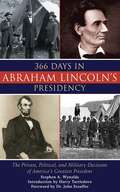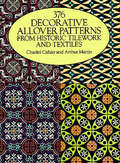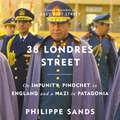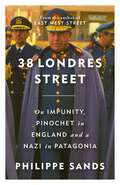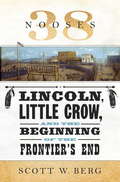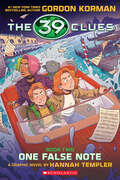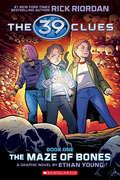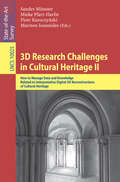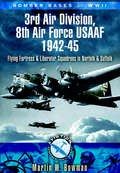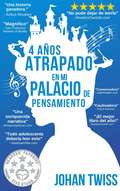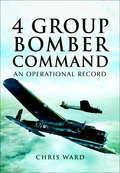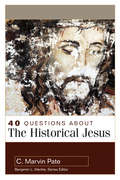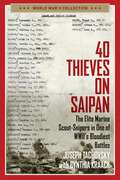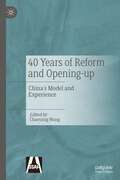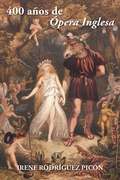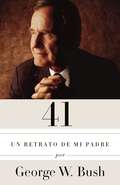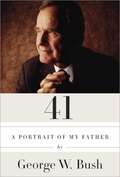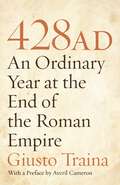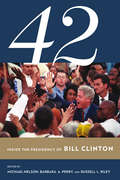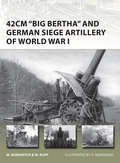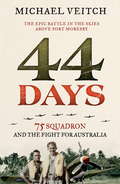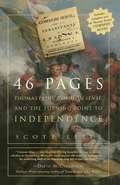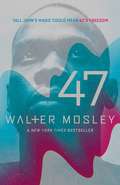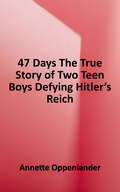- Table View
- List View
366 Days in Abraham Lincoln's Presidency: The Private, Political, and Military Decisions of America's Greatest President
by Harry Turtledove Stephen A. WynaldaIn a startlingly innovative format, journalist Stephen A. Wynalda has constructed a painstakingly detailed day-by-day breakdown of president Abraham Lincoln's decisions in office-including his signing of the Homestead Act on May 20, 1862; his signing of the legislation enacting the first federal income tax on August 5, 1861; and more personal incidents like the day his eleven-year-old son, Willie, died. Revealed are Lincoln's private frustrations on September 28, 1862, as he wrote to vice president Hannibal Hamlin, "The North responds to the [Emancipation] proclamation sufficiently with breath; but breath alone kills no rebels." 366 Days in Abraham Lincoln's Presidency includes fascinating facts like how Lincoln hated to hunt but loved to fire guns near the unfinished Washington monument, how he was the only president to own a patent, and how he recited Scottish poetry to relieve stress. As Scottish historian Hugh Blair said, "It is from private life, from familiar, domestic, and seemingly trivial occurrences, that we most often receive light into the real character." Covering 366 nonconsecutive days (including a leap day) of Lincoln's presidency, this is a rich, exciting new perspective of our most famous president. This is a must-have edition for any historian, military history or civil war buff, or reader of biographies.
376 Decorative Allover Patterns from Historic Tilework and Textiles (Dover Pictorial Archive)
by Arthur Martin Charles CahierThe increased use of quality designs in 19th-century manufactured goods created a steady demand during that period for collections of decorative patterns. This volume reproduces one such collection - an extremely rare and valuable portfolio of 376 motifs assembled more than a century ago by two French Jesuit scholars. Relying on historical wall and floor tiles, textile patterns, tapestries, wall hangings, and other designs originating in the Middle Ages, the Renaissance, and later European and Islamic cultures, Charles Cahier (1807-1882) and Arthur Martin (1802-1856) produced a work of true artistic distinction. Included are a wealth of splendid floral, animal, bird, and geometric patterns, carefully researched and meticulously redrawn for use in a myriad of graphic and artistic projects. Many of the motifs are accompanied by complementary border designs, an often essential accessory. This edition faithfully reproduces the edition published in 1868, titled Suite aux mélanges d'archéologie. It represents an invaluable copyright-free resource embodying the finest designs from historic sources, ready for use by artists, illustrators, craftspeople, and designers working with textiles, wallpapers, interior decoration, and other projects.
38 Londres Street: On Impunity, Pinochet in England and a Nazi in Patagonia
by Philippe SandsIn 38 Londres Street, Philippe Sands blends personal memoir, historical detective work and gripping courtroom drama to probe a secret double story of mass murder, one that reveals a shocking thread that links the horrors of the 1940s with those of our own times. The house at 38 Londres Street is home to the legacies of two men whose personal stories span continents, nationalities and decades of atrocity: Augusto Pinochet, President of Chile, and Walther Rauff, a Nazi SS officer responsible for the use of gas vans.On the run from justice at the end of the Second World War, Rauff crosses the ocean to southern Chile. He settles in Punta Arenas, Patagonia, managing a king crab cannery at the end of the world. But there are whispers about this discreet and self-possessed German - rumours of a second career with Pinochet's secret intelligence service, the dreaded DINA.In 1998, Pinochet is in a London medical clinic when the police enter his room and arrest him on charges of crimes against humanity and genocide. Philippe Sands is called to advise the former head of state on his claim to immunity, but will instead represent a human rights organisation against him. Years later, Sands makes a discovery while working on another book which reignites his interest in the case and leads to a decades-long investigation into Pinochet's crimes, his unexpected connection to Rauff and the former Nazi's possible connection to Chile's disappeared.
38 Londres Street: On Impunity, Pinochet in England and a Nazi in Patagonia
by Philippe SandsIn 38 Londres Street, Philippe Sands blends personal memoir, historical detective work and gripping courtroom drama to probe a secret double story of mass murder, one that reveals a shocking thread that links the horrors of the 1940s with those of our own times. The house at 38 Londres Street is home to the legacies of two men whose personal stories span continents, nationalities and decades of atrocity: Augusto Pinochet, President of Chile, and Walther Rauff, a Nazi SS officer responsible for the use of gas vans.On the run from justice at the end of the Second World War, Rauff crosses the ocean to southern Chile. He settles in Punta Arenas, Patagonia, managing a king crab cannery at the end of the world. But there are whispers about this discreet and self-possessed German - rumours of a second career with Pinochet's secret intelligence service, the dreaded DINA.In 1998, Pinochet is in a London medical clinic when the police enter his room and arrest him on charges of crimes against humanity and genocide. Philippe Sands is called to advise the former head of state on his claim to immunity, but will instead represent a human rights organisation against him. Years later, Sands makes a discovery while working on another book which reignites his interest in the case and leads to a decades-long investigation into Pinochet's crimes, his unexpected connection to Rauff and the former Nazi's possible connection to Chile's disappeared.
38 Nooses: Lincoln, Little Crow, and the Beginning of the Frontier's End
by Scott W. BergIn August 1862, after decades of broken treaties, increasing hardship, and relentless encroachment on their lands, a group of Dakota warriors convened a council at the tepee of their leader, Little Crow. Knowing the strength and resilience of the young American nation, Little Crow counseled caution, but anger won the day. Forced to either lead his warriors in a war he knew they could not win or leave them to their fates, he declared, "[Little Crow] is not a coward: he will die with you." So began six weeks of intense conflict along the Minnesota frontier as the Dakotas clashed with settlers and federal troops, all the while searching for allies in their struggle. Once the uprising was smashed and the Dakotas captured, a military commission was convened, which quickly found more than three hundred Indians guilty of murder. President Lincoln, embroiled in the most devastating period of the Civil War, personally intervened in order to spare the lives of 265 of the condemned men, but the toll on the Dakota nation was still staggering: a way of life destroyed, a tribe forcibly relocated to barren and unfamiliar territory, and 38 Dakota warriors hanged--the largest government-sanctioned execution in American history. Scott W. Berg recounts the conflict through the stories of several remarkable characters, including Little Crow, who foresaw how ruinous the conflict would be for his tribe; Sarah Wakefield, who had been captured by the Dakotas, then vilified as an "Indian lover" when she defended them; Minnesota bishop Henry Benjamin Whipple, who was a tireless advocate for the Indians' cause; and Lincoln, who transcended his own family history to pursue justice.Written with uncommon immediacy and insight, 38 Nooses details these events within the larger context of the Civil War, the history of the Dakota people, and the subsequent United States-Indian wars. It is a revelation of an overlooked but seminal moment in American history.
39 Clues: One False Note: A Graphic Novel (The 39 Clues)
by Gordon KormanThe second installment in the mega-bestselling The 39 Clues series, now in graphic novel form!Amy and Dan made the choice of a lifetime when they gave up a million dollars in favor of a Clue and joined a competition unlike any the world has ever seen. After barely escaping Paris with their lives, now they're in Vienna to discover the truth about their famous ancestor, Wolfgang Amadeus Mozart, and the long-buried secrets connected to his equally talented but overlooked sister, Nannerl.But with their enemies closing in, Amy and Dan must decide how much they're willing to risk to find the clues, and who they're willing to betray in the process...
39 Clues: The Maze of Bones: A Graphic Novel (39 Clues Graphic Novel #1)
by Rick RiordanThe graphic novel adaptation of the mega-bestseller that launched a global phenomenon!Minutes before she died Grace Cahill changed her will, leaving her decendants an impossible decision: "You have a choice - one million dollars or a clue."Grace is the last matriarch of the Cahills, the world's most powerful family. Everyone from Marie Curie to Harry Houdini is related to the Cahills, yet the source of the family power is lost. 39 Clues hidden around the world will reveal the family's secret, but no one has been able to assemble them. Now the clues race is on, and young Amy and Dan must decide what's important: hunting clues or uncovering what REALLY happened to their parents.
3D Research Challenges in Cultural Heritage II: How to Manage Data and Knowledge Related to Interpretative Digital 3D Reconstructions of Cultural Heritage (Lecture Notes in Computer Science #10025)
by Sander Münster Mieke Pfarr-Harfst Piotr Kuroczyński Marinos IoannidesThis book reflects a current state of the art and future perspectives of Digital Heritage focusing on not interpretative reconstruction and including as well as bridging practical and theoretical perspectives, strategies and approaches. Comprehensive key challenges are related to knowledge transfer and management as well as data handling within a interpretative digital reconstruction of Cultural Heritage including aspects of digital object creation, sustainability, accessibility, documentation, presentation, preservation and more general scientific compatibility. The three parts of the book provide an overview of a scope of usage scenarios, a current state of infrastructures as digital libraries, information repositories for an interpretative reconstruction of Cultural Heritage; highlight strategies, practices and principles currently used to ensure compatibility, reusability and sustainability of data objects and related knowledge within a 3D reconstruction work process on a day to day work basis; and show innovative concepts for the exchange, publishing and management of 3D objects and for inherit knowledge about data, workflows and semantic structures.
3rd Air Division 8th Air Force USAF 1942-45: Flying Fortress and Liberator Squadrons in Norfolk and Suffolk (Bomber Bases of WW2)
by Martin W. BowmanA history and guide to the historic British airfields where American bombers had to be ready to go at a moment&’s notice—includes photos. A magnificent centuries-old house in England, Elveden Hall served as the Headquarters of the 3rd Air Division of the 8th US Army Air Force during the Second World War. Broadly speaking, it flew B17 Flying Fortresses out of Suffolk, but also included some bases in Norfolk. Some units had short periods flying B24 Liberators. The famous Bloody Hundredth, based at Thorpe Abbotts, was typical of the units within the 3rd Air Division. This guide offers at comprehensive look at the history, covering: Targets: enemy airfields, submarine facilities, V-1 missile sites; aircraft factoriesMissions and campaigns: Big Week, the first daylight raid on Berlin, the Battle of the BulgeAirfields: Bury St Edmunds, Debach, Deopham Green Eye, Framlington, Great Ashfield, Horham, Knettishall, Lavenham, Mendlesham, Rattlesden, Snetterton Heath, Sudbury, and Thorpe Abbotts—site of one of finest aviation museums in EnglandStories and personalities associated with each base, and local haunts where air and ground crew would have taken a break from the pressures of wartime What remains today, including museums and historic sites
4 Años Atrapado en mi Palacio de Pensamiento
by Johan Twiss“Estuve paralizado de pies a cabeza, atrapado en mi propia mente. Pero todo cambió cuando un hombre viejo con demencia escuchó mis pensamientos.” Un adolescente, diagnosticado con una forma rara de meningitis, está paralizado y atrapado en su propia mente. Para lidiar con su encarcelamiento, él se refugia en un mundo imaginario llamado su Palacio de Pensamiento. Pero las líneas entre la realidad y el tiempo empiezan a volverse borrosas y se vuelven en aventuras inesperadas cuando viene un nuevo compañero de habitación – el músico de jazz judío, viejo y franco con demencia.
4 Group Bomber Command: An Operational Record
by Chris WardDuring the immediate period before World War Two, the RAF modified its command structure to rationalize for rapid expansion. Bomber Command was divided into six operational groups, each flying the same type of aircraft, including Wellingtons, Sterlings, and Lancasters. Chris Ward presents us here with the history of 4 Group Bomber Command, having previously acquainted us with the histories of 3, 5, and 6 Group Bomber Commands in three highly acclaimed volumes, published by Pen and Sword. He continues with characteristic ease, quality of research, and narrative pace, to present us with an operational record of the groups activities during a particularly dramatic period of aviation history.The book contains individual squadron statistics, their commanding officers, stations and aircraft losses. It provides a detailed reference for one of the RAFs most important operational groups.
40 Questions About the Historical Jesus (40 Questions Series)
by C. Marvin PateAnswers to critical questions regarding the study of the Jesus of history and the Christ of faithThe conclusions of the quest for the historical Jesus, which casts the majority of Christ's life as a myth, are a stark contrast to the orthodox view of Christ as presented in the Bible. Pate demonstrates that a critical analysis of the gospel text along with historical and cultural methods of investigation actually point toward an orthodox view of Christ.This work argues that the canonical Gospels are the most trustworthy information we have about the gospel writers as well as the life and ministry of Jesus, including his death, visit to hades, resurrection, and ascension. Readers will be encouraged by the reliability of the Gospel writers, the reality of Jesus' humanity and deity, and the inferiority of the apocryphal gospels.
40 Thieves on Saipan: The Elite Marine Scout-Snipers in One of WWII's Bloodiest Battles
by Joseph TachovskyBefore there were Navy SEALs, before there were Green Berets, there were the 40 Thieves: the elite Scout Sniper Platoon of the Sixth Marine Regiment during World War II. Behind enemy lines on the island of Saipan—where firing a gun could mean instant discovery and death—the 40 Thieves killed in silence during the grueling battle for Saipan, the "D-Day" of the Pacific. Now Joseph Tachovsky—whose father Frank was the commanding officer of the 40 Thieves, also called "Tachovsky's Terrors"—joins with award-winning author Cynthia Kraack to transport readers back to the brutal Battle of Saipan. Built on hours of personal interviews with WWII veterans, their personal papers, letters and documentation from the National Archives, 40 Thieves on Saipan is an astonishing portrayal of elite World War II combat. It's also a rare glimpse into the lives of World War II Marines. The poorest equipped branch of the services at that time, Marines were notorious thieves. To improve their odds for victory against the Japanese, they found it necessary to improve their supply chains through &“Marine Methods,&” stealing. Being the elite of the Sixth Regiment, the Scout-Sniper Platoon excelled at the craft—earning them the nickname of the &“40 Thieves&” from their envious peers. Upon returning from a 1943 trip to the Pacific theater, Eleanor Roosevelt observed, &“The Marines I have met around the world have the cleanest bodies, the filthiest minds, the highest morale and the lowest morals of any group of animals I have ever seen. Thank God for the United States Marines.&”
40 Years of Reform and Opening-up: China's Model and Experience
by Chaoyang WangThis book consists of studies on China’s economic development since China carried out the reform and opening-up strategy, including China’s economic restructuring, economic operational mechanism, socialist market economy, inflation, the reform of the urban housing system, the economic impact of WTO entry, the future potential growth rate, global economic governance, structural fiscal and taxation reforms, the rapid growth of China’s financial industry, and more. These studies explores China’s successful experience of economic growth in the past and will shed some light on China’s economic development in the future, providing value to economists and Chinese scholars.
400 años de Ópera inglesa
by Irene Rodriguez PiconLa ópera nunca ha sido tomada en serio literariamente. Como ocurre con el cine, dirigido a un público de masas, poco acostumbrado al análisis interior. Este es el libro que la autora siempre quiso leer, buscó y jamás encontró. En él aparece la ópera inglesa, menospreciada secularmente, como una categoría definida, inscrita dentro del magnífico teatro inglés de todos los tiempos. El estudio se basa en una investigación doctoral premiada por la Universidad Complutense de Madrid. En un amplio recorrido por los contextos literarios que nutren la ópera inglesa se observa su variación según los gustos de las distintas épocas, aunque con excepciones como es el caso de Shakespeare, denominador común desde las primeras composiciones renacentistas hasta la actualidad. Durante la investigación, pronto surgió el convencimiento de que en la ópera británica los nombres de Henry Purcell y Benjamin Britten destacan sobre los demás. Sin embargo, entre ambos hay mas de trescientos años, de cuyo análisis se desprende que la calidad de la opera inglesa depende de la coherencia entre texto y música; y que la perfección se puede alcanzar tanto con la liviandad de autores de la talla de Gilbert & Sullivan, como con la seriedad de las óperas contemporáneas, basadas en una literatura de libreto, tan válida como la partitura musical.
4000 Miles and After the Revolution
by Amy Herzog"After the Revolution is a smart, funny and provocative play. . . . Herzog deftly avoids simple-minded polemics in favor of richly detailed people who are as ready to examine their relationships as they are their consciences."--Variety "A funny, moving new play . . . 4,000 Miles is a quiet meditation on mortality. But it's hardly a downer: Ms. Herzog's altogether wonderful drama also illuminates how companionship can make life meaningful, moment by moment, in death's discomforting shadow."--The New York Times Known for delicately detailed character studies that subtly balance humor and insight, Amy Herzog is swiftly emerging as a striking new voice in the American theater. After the Revolution, an astute and ironic drama about how society appropriates history for its own psychological needs, was heralded by The New York Times as one of the Ten Best New Plays of 2010. Herzog's other critical hit, 4,000 Miles, is a quiet rumination on mortality in which twenty-one-year-old Leo seeks solace from his feisty ninety-one-year-old grandmother Vera in her New York apartment. Amy Herzog received the 2011 Whiting Writers' Award and the 2008 Helen Merrill Award for Aspiring Playwrights. Her plays have been produced or developed at the Yale School of Drama, Ensemble Studio Theater, Arena Stage, Lincoln Center, The Actors Theatre of Louisville, New York Stage and Film, Provincetown Playhouse, and ACT in San Francisco. Her newest play, Belleville, premiered at Yale Rep in fall 2011.
41
by George W. BushNunca desde los tiempos de John Quincy Adams y John Adams en la Casa Blanca hace 190 años han sido padre e hijo presidentes de los Estados Unidos. En 41: un retrato de mi padre, George W. Bush el presidente número 43, nos guía a lo largo de la vida y el liderazgo de su padre, George H.W. Bush, el presidente número 41. Íntimo y conmovedor, 41 es un libro que solo un hijo y también presidente podía escribir. La vida de George H.W. Bush es una gran historia americana. A raíz del ataque a Pearl Harbor y contra los deseos de su padre, pospuso sus estudios para pilotar en las fuerzas armadas durante la Segunda Guerra Mundial. Tras varias misiones en el Pacífico, regreso a Estados Unidos donde se casó con Barbara Pierce, la mujer que tanta influencia tendría sobre padre e hijo. Tras una exitosa carrera en Wall Street, su espíritu aventurero hizo que la joven familia se trasladara a Texas. Recordando su niñez en Midland, Texas, George W. Bush explora como su padre desarrolló su instinto, su capacidad para las relaciones personales, y su habilidad para arriesgar al tiempo que triunfaba en el mundo del petróleo primero y en política después. George W. Bush describe las extraordinarias tres décadas de su padre en la política en el Congreso primero, más tarde como embajador, director de la CIA, vicepresidente bajo Ronald Reagan y finalmente presidente de los Estados Unidos en 1988. Pero más que una biografía, 41 nos ofrece las lecciones que un hijo aprendió del hombre al que admira y adora. George W. Bush reflexiona sobre la influencia que su padre tuvo en su vida tanto personal como política, y revela como el apoyo constante y silencioso de su padre lo ayudó en los momentos más difíciles. George H.W. Bush fue uno de los políticos más influyentes norteamericano del siglo XX, y uno de los hombres de estado más queridos del siglo XXI. 41 es un emotivo tributo a un inspirador padre y a un gran estadounidense.
41: A Portrait of My Father
by George W. BushGeorge W. Bush, the 43rd President of the United States, has authored a personal biography of his father, George H. W. Bush, the 41st President. <P> Forty-three men have served as President of the United States. Countless books have been written about them. But never before has a President told the story of his father, another President, through his own eyes and in his own words. A unique and intimate biography, the book covers the entire scope of the elder President Bush’s life and career, including his service in the Pacific during World War II, his pioneering work in the Texas oil business, and his political rise as a Congressman, U.S. Representative to China and the United Nations, CIA Director, Vice President, and President. The book shines new light on both the accomplished statesman and the warm, decent man known best by his family. In addition, George W. Bush discusses his father’s influence on him throughout his own life, from his childhood in West Texas to his early campaign trips with his father, and from his decision to go into politics to his own two-term Presidency.
428 AD: An Ordinary Year at the End of the Roman Empire
by Giusto TrainaThis is a sweeping tour of the Mediterranean world from the Atlantic to Persia during the last half-century of the Roman Empire. By focusing on a single year not overshadowed by an epochal event, 428 AD provides a truly fresh look at a civilization in the midst of enormous change--as Christianity takes hold in rural areas across the empire, as western Roman provinces fall away from those in the Byzantine east, and as power shifts from Rome to Constantinople. Taking readers on a journey through the region, Giusto Traina describes the empires' people, places, and events in all their simultaneous richness and variety. The result is an original snapshot of a fraying Roman world on the edge of the medieval era. The result is an original snapshot of a fraying Roman world on the edge of the medieval era. Readers meet many important figures, including the Roman general Flavius Dionysius as he encounters a delegation from Persia after the Sassanids annex Armenia; the Christian ascetic Simeon Stylites as he stands and preaches atop his column near Antioch; the eastern Roman emperor Theodosius II as he prepares to commission his legal code; and Genseric as he is elected king of the Vandals and begins to turn his people into a formidable power. We are also introduced to Pulcheria, the powerful sister of Theodosius, and Galla Placidia, the queen mother of the western empire, as well as Augustine, Pope Celestine I, and nine-year-old Roman emperor Valentinian III. Full of telling details, 428 AD illustrates the uneven march of history. As the west unravels, the east remains intact. As Christianity spreads, pagan ideas and schools persist. And, despite the presence of the forces that will eventually tear the classical world apart, Rome remains at the center, exerting a powerful unifying force over disparate peoples stretched across the Mediterranean.
42: Inside the Presidency of Bill Clinton (Miller Center of Public Affairs Books)
by Michael Nelson Barbara A. Perry Russell L. RileyThis book uses hundreds of hours of newly opened interviews and other sources to illuminate the life and times of the nation's forty-second president, Bill Clinton. Combining the authoritative perspective of these inside accounts with the analytic powers of some of America's most distinguished presidential scholars, the essays assembled here offer a major advance in our collective understanding of the Clinton White House. Included are path-breaking chapters on the major domestic and foreign policy initiatives of the Clinton years, as well as objective discussions of political success and failure. p>42 is the first book to make extensive use of previously closed interviews collected for the Clinton Presidential History Project, conducted by the Presidential Oral History Program of the University of Virginia's Miller Center. These interviews, recorded by teams of scholars working under a veil of strict confidentiality, explored officials' memories of their service with President Clinton and their careers prior to joining the administration. Interviewees also offered political and leadership lessons they had gleaned as eyewitnesses to and shapers of history. Their spoken recollections provide invaluable detail about the inner history of the presidency in an age when personal diaries and discursive letters are seldom written. The authors producing this volume had first access to more than fifty of these cleared interviews, including sessions with White House chiefs of staff Mack McLarty and Leon Panetta, Secretaries of State Warren Christopher and Madeleine Albright, National Security Advisors Anthony Lake and Sandy Berger, and a host of political advisors who guided Clinton into the White House and helped keep him there. This book thus provides a multidimensional portrait of Bill Clinton's administration, drawing largely on the observations of those who knew it best.p>ContributorsSpencer D. Bakich, University of RichmondBrendan J. Doherty, United States Naval AcademyPatrick T. Hickey, West Virginia Universityp>Elaine Kamarck, Center for Effective Public Management, Brookings InstitutionSidney M. Milkis, University of VirginiaMegan Moeller, University of Texas at AustinMichael Nelson, Rhodes College and the Miller Center, University of Virginia>Bruce F. Nesmith, Coe CollegeBarbara A. Perry, Miller Center, University of VirginiaPaul J. Quirk, University of British Columbiap>Russell L. Riley, Miller Center, University of Virginia Andrew Rudalevige, Bowdoin CollegeRobert A. Strong, Washington and Lee UniversitySean M. Theriault, University of Texas at Austin
42cm "Big Bertha" and German Siege Artillery of World War I
by Henry Morshead Marc RomanychBig Bertha, Germany's World War I top secret mobile artillery piece, easily destroyed French and Belgian forts, helping set the stage for trench warfare.In the first days of World War I, Germany unveiled a new weapon - the mobile 42cm (16.5 inch) M-Gerät howitzer. At the time, it was the largest artillery piece of its kind in the world and a closely guarded secret. When war broke out, two of the howitzers were rushed directly from the factory to Liege where they quickly destroyed two forts and compelled the fortress to surrender. After repeat performances at Namur, Maubeuge and Antwerp, German soldiers christened the howitzers 'Grosse' or 'Dicke Berta' (Fat or Big Bertha) after Bertha von Krupp, owner of the Krupp armament works that built the howitzers. The nickname was soon picked up by German press which triumphed the 42cm howitzers as Wunderwaffe (wonder weapons), and the legend of Big Bertha was born. To the Allies, the existence of the howitzers came as a complete surprise and the sudden fall of the Belgian fortresses spawned rumors and misinformation, adding to the 42cm howitzer's mythology.In reality, 'Big Bertha" was but the last in a series of large-caliber siege guns designed by the German Army for the purpose of destroying concrete fortifications. It was also only one of two types of 42cm calibre howitzers built for the army by Krupp and only a small part of the siege artillery available to the German Army at the outset of the war. Such were the successes of the German siege guns that both the French and British Armies decided to field their own heavy siege guns and, after the German guns handily destroyed Russian forts during the German offensives in the east in 1915, the French Army abandoned their forts. However, by 1916, as the war settled into a stalemate, the effectiveness of the siege guns diminished until, by war's end, 'Big Bertha' and the other siege guns were themselves outmoded. This book details the design and development of German siege guns before and during World War I, to include four models of 30.5cm mortars, two versions of 28cm howitzers, and two types of 42cm howitzers (including 'Big Bertha'); in total, eight different types of siege guns. Accompanying the text are many rare, never before published, photographs of 'Big Bertha' and the other German siege guns. Colour illustrations depict the most important aspects of the German siege artillery.
44 Days: 75 Squadron and the Fight for Australia
by Michael VeitchThe epic World War II story of Australia's 75 Squadron - and the 44 days when these brave and barely trained pilots fought alone against the Japanese.In March and April 1942, RAAF 75 Squadron bravely defended Port Moresby for 44 days when Australia truly stood alone against the Japanese. This group of raw young recruits scrambled ceaselessly in their Kittyhawk fighters to an extraordinary and heroic battle, the story of which has been left largely untold.The recruits had almost nothing going for them against the Japanese war machine, except for one extraordinary leader named John Jackson, a balding, tubby Queenslander - at 35 possibly the oldest fighter pilot in the world - who said little, led from the front, and who had absolutely no sense of physical fear.Time and time again this brave group were hurled into battle, against all odds and logic, and succeeded in mauling a far superior enemy - whilst also fighting against the air force hierarchy. After relentless attack, the squadron was almost wiped out by the time relief came, having succeeded in their mission - but also paying a terrible price.Michael Veitch, actor, presenter and critically acclaimed author, brings to life the incredible exploits and tragic sacrifices of this courageous squadron of Australian heroes.
46 Pages: Thomas Paine, Common Sense, and the Turning Point to American Independence
by Scott LiellThomas Paine, a native of Thetford, England, arrived in America's colonies with little in the way of money, reputation, or prospects, though he did have a letter of recommendation in his pocket from Benjamin Franklin. Paine also had a passion for liberty in all its forms, and an abiding hatred of tyranny. His forceful, direct expression of those principles found voice in a pamphlet he wrote entitled Common Sense, which proved to be the most influential political work of the time. Ultimately, Paine's treatise provided inspiration to the second Continental Congress for the drafting of the Declaration of Independence. 46 Pages is a dramatic look at a pivotal moment in our country's formation, a scholar's meticulous recreation of the turbulent years leading up to the Revolutionary War, retold with excitement and new insight.
47
by Walter Mosley<P>In his first book for young adults, bestselling author Walter Mosley weaves historical and speculative fiction into a powerful narrative about the nature of freedom. <P>47 is a young slave boy living under the watchful eye of a brutal slave master. His life seems doomed until he meets a mysterious runaway slave, Tall John. <P>47 soon finds himself swept up in an otherworldly battle and a personal struggle for his own liberation.
47 Days: The True Story of Two Teen Boys Defying Hitler's Reich
by Annette OppenlanderIn March 1945 Hitler ordered his last propaganda command: send all 15 and 16-year-old boys to defend the fatherland. 47 DAYS tells the true story of Günter and Helmut, best friends, who dared to defy and disobey. Without knowing how long the war might continue, they spent 47 harrowing days as fugitives on the run. Being caught meant certain execution. 47 DAYS is a novelette, an excerpt from the novel, SURVING THE FATHERLAND--A True Coming-of-age Love Story Set in WWII Germany, a sweeping saga of family, love, and betrayal against the epic panorama of WWII which illuminates an intimate part of history seldom seen: the children's war.
